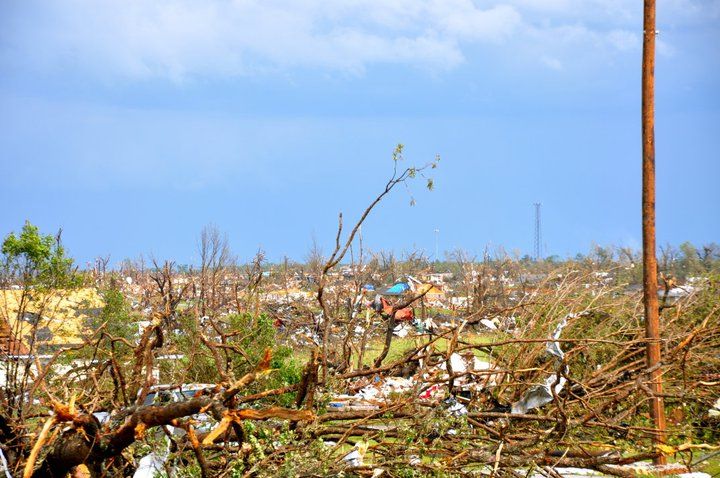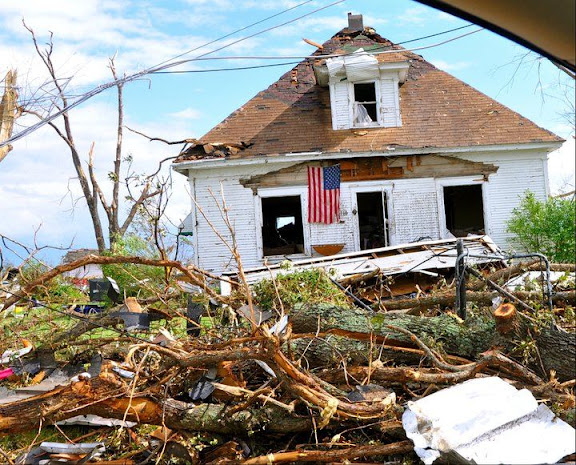Energy Corps to the Rescue

It was a beautiful day in Fayetteville, Arkansas, on May 22, 2011. My EnergyCorps colleague, Becky Roark, and I had been sharing energy efficiency information from EcoLogical Communities at the Block Street Event. The skies were blue and the air was crisp with a light breeze. Little did we know, storms were brewing all around us and that the next morning would bring a devastating reminder of the power of Mother Nature…
That evening, sirens and weather alerts notified us that tornados were touching down all around us across a region the size of Texas. Our neighbors to the north in Joplin, Missouri, were slammed by an EF5 tornado, which cleared a path over a mile wide and six miles long right through the city, leaving 160 dead in its wake.
AmeriCorps and its subsidiary members from EnergyCorps were some of the first responders. Fayetteville’s chapter of EnergyCorps is only an hour and a half from Joplin, so we took off for the affected area as soon as we got the green light.The eleven of us who volunteered to go to Joplin took along four large vehicles full of food, bedding, diapers, car seats and stuffed animals. We were told that a large portion of Joplin had lost absolutely everything.
This is truly impossible to grasp from any kind of distance; one cannot understand exactly the extent and devastation of a tornado — particularly an EF5, which is not supposed to be survivable above ground, according to the experts — until one tours the disaster area and witnesses it first-hand.I noticed the overwhelming smell of exposed wood as we travelled from the “Green Belt” area of town, where damage was less, and homeowners could still live in their houses, to the “Ground Zero” area, where all we could see all around us was a brown, leveled layer of destruction.
About 48 hours after the tornado hit, emergency workers began allowing volunteers into the area. Emergency crews were still working to rescue victims trapped in their damaged homes — and recovering the bodies of those who were even less fortunate.After arriving and unloading our vehicles at a local church that opened its doors to serve a drop-off and processing center for all donations, we met at Missouri Southern State University, the makeshift local headquarters for AmeriCorps.
At MSSU, our team assisted in setting up the American Red Cross Shelter. We put up cots in the designated sleeping quarters, and tables and chairs in the dining area. The displaced citizens were so happy to see us, and even though we were unfamiliar faces, we were instant friends as we listened to their stories — reminding each of us quickly that sometimes that’s what is needed at a time of trauma: just someone to lean on, to talk to.
It was such a humbling experience, and as we drove back to Fayetteville at the end of that day, we realized a new, deeper appreciation for the “everyday” blessings in our lives: a roof over our heads, food at our fingertips and the opportunity to pursue happiness, morning after morning.
Day Two of our journey brought an entirely different experience. AmeriCorps members were assigned to canvass the Green Belt, going door-to-door, inquiring where we could assist and what tools were needed.
That morning, buses took us right into the middle of it all. Gathered in a large parking lot, we broke into groups.Each AmeriCorps member was appointed to lead a crew of all kinds of volunteers who’d just arrived from all over the United States.
After some quick instructions, I along with the team of volunteers that I’d been assigned to lead began our slow march across a few blocks that had already been checked by emergency crews for victims. We went from house to house, introducing ourselves and starting the very first stages of the long clean-up — and healing — process.Some homes had broken windows, some downed power lines, others sat buried under the remnants of trees,and all of them had lots of debris. Our team worked hard sorting debris into piles of trash, recyclables and brush, lining the streets at each residence.
During lunch break, sitting on a doorstep eating a sandwich that a crew had dropped off on our block, my EnergyCorps director, Melissa Terry, called and asked that my team and I walk over several blocks and join a search and rescue for a young man, Will Norton, who was reportedly possibly trapped in a ravine.
The boy’s uncle had called the emergency line at the college where Melissa was stationed and begged for volunteersto immediately look for his nephew. He said the tornado’s winds had sucked Will up through the sunroof of the SUV that he had been driving on his way home from his high school graduation that evening. Sitting next to him in the SUV, his father held on to Will with everything he could muster, but he was no match for the EF5’s winds, which have been estimated by scientists as being above 200 miles per hour.
When Melissa asked us to join the search, I was eager to help — as a mother of two young children, there was never even a question of where I wanted to be. I shared the details with my team, and we went across town on foot, where we met up with Will’s uncle.
Once at the ravine, we fought our way through downed, 100-year-old trees that had fallen in a criss-cross pattern, overlapping a bridge over the ravine.As it happened, two of the girls volunteering on my team were classmates of Will. We were all on a mission to help, but they were there to find their friend. We worked the rest of the day, and when darkness fell, I didn’t want the day to end because our work was not finished.
We had been looking for a needle in a haystack, and all that was found was a few dollars floating in some leaves and branches. My heart had never felt so heavy. Part of me was glad that we had not seen death that day in the ravine, but my heart ached for this boy and his family.
A few days later, Will’s body was found in a nearby pond.
After our search that day on the drive home, we once again were forced by the realities of what we’d seen (and not seen) to ponder how fortunate we are — and we also had quickly developed a deeper appreciation and respect for first responders.
•••
A few months later, on August 26, 2011, AmeriCorps members were invited to a Kansas City Chiefs vs. St. Louis Rams football game at Arrowhead Stadium in Kansas City, Missouri, which is a short drive from Joplin.
At that game, AmeriCorps volunteers were acknowledged for our service in Joplin. Before kick-off, hundreds of AmeriCorps members gathered on the field and unraveled an enormous American flag. This was such an amazing experience, and one we will each remember for a lifetime. I felt so proud! Proud of my service, proud of my team and all the other AmeriCorps members, and proud to be an American!
More recently, on February 16, 2012, at the Arkansas State Capitol in Little Rock, we were recognized bythe Missouri State Legislature for our efforts after the devastating tornado in Joplin. Arkansas State Senator Randy Laverty, representing Carroll, Madison, Newton, Sercy and parts of Johnson and Boone counties, presented us with a plaque from the Governor of Missouri and thanked us for our service.
AmeriCorps: United WE Serve. We get things done!
This recount of the Joplin, MO disaster was submitted by Arkansas member Shannon Joyce.











